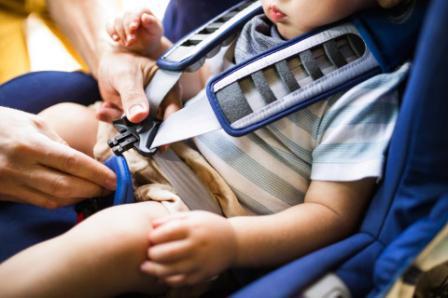
New parents often spend days agonising over which car seat will best ensure their child's safety on the roads.
But a worrying new study has revealed that two out of three children are not safe in their car seats - and it's because of easy oversights made by parents.
The What? Car study concluded that the most common of all car safety errors were incorrectly placed seat belts and ill-positioned headrests.
After inspecting the children's seats in over 3,000 British family cars, the researchers found that 33 per cent of seats were unsuitable to protect the child they were carrying.
A further 36 per cent were incorrectly fitted to the car which was among one of many mistakes researchers said are "simple and easy to avoid."
The most common of these were seat belts needing tightening, harnesses not being in the right position, and incorrect head restraints.
But parents who rely on impact-shield seats for their little ones can rest easy as over 90 per cent of drivers had installed them correctly.
However, only two thirds of older children were found to be satisfactorily secure in their harness car seats meaning that parents should take more care when securing these safety precautions.
The consumer editor of What Car? Claire Evans said that the organisation recommends trying the children's seat in the car before purchasing the item, "ideally with their child in it."
In the UK, children are legally required to remain in a car-seat until they are either 12-years-old or at least 4ft 4 inches.
But road safety companies advise parents to keep their children in car seats until they are almost reach 5ft, regardless of their age.
Top 10 Car Seat Checks
1.Seek expert advice if you think your child is too big for their seat.
2.The car seat should be tight enough that it doesn’t move when you push it. If the seat is secured by the car seatbelt, check that it is not twisted and that it is fitted tightly enough around the child seat.
3.To ensure your ensure your child's harness is tight enough, pinch it in front of your child’s collarbone. If you can get a good pinch of fabric between your fingers, it’s too loose.
4.If you’ve adjusted the seat’s head rest because your child has grown, ensure that the harness has been correctly routed back into place.
5.If you’re using a travel system seat with a carry handle, don’t forget to put it back to the correct position after putting your child in the seat.
6.If you’re using an Isofix seat, check that it is correctly clipped in. Indicators on the seat will change from red to green when it’s fitted correctly.
7.If you’re using a seat with a leg support, check that the leg is fitted firmly to the car’s floor, that it’s at a 90deg angle to the floor and that it’s not resting on an underfloor storage compartment.
8.If you’re using a seat with a top tether, ensure it is routed over the back of the seat and clipped into the correct mounting point, not a luggage hook.
9.Don’t secure a high-back booster with the car’s head rest; this needs to be moved out of the way so the child seat sits flush with the car seatback.
10.If you’re using a seat that’s suitable for a wide age range, check it regularly for wear and tear; don’t just assume it’ll stay safe for many years
Source: The Sun
 FR
FR EN
EN AR
AR








